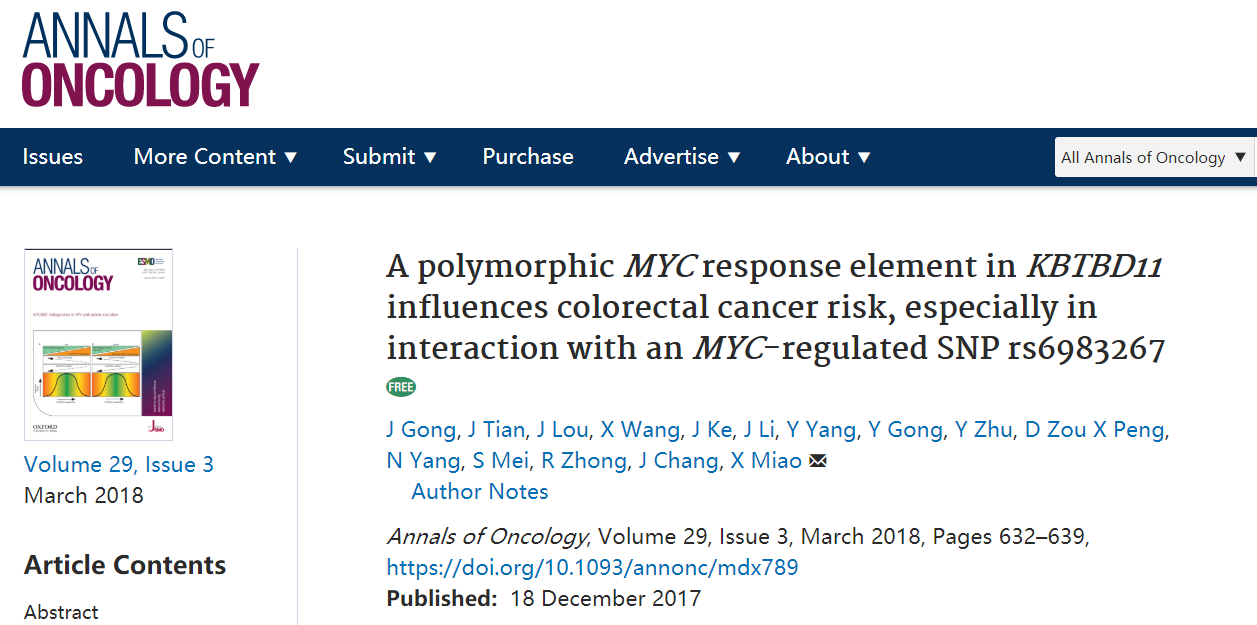Wuhan, China — Recently, Prof. Miao Xiaoping's group of School of Public Health has made important progress in the field of gene-gene interaction in colorectal cancer. The research named "A polymorphic MYC response element in KBTBD11 influences colorectal cancer risk, especially in interaction with an MYC- regulated SNP rs6983267" was published in Ann Oncol (IF: 11.8). Prof. Miao Xiaoping from Huazhong University of Science and Technology is the corresponding author of the paper. Dr. Gong Jing and Ph.D. candidate Tian Jianbo are the co-first authors of the paper.
The c-Myc (MYC) gene is a well-established oncogene that functions as a pleiotropic transcription factor, and is estimated to bind to over 10% of genes in different cell types, which thus plays essential roles in cell cycle progression, apoptosis and cellular transformation. The above evidence indicates that MYC is an important gene in CRC, and SNPs in MYC response elements may influence MYC binding affinity and affect the expression of its target genes, thus leading to differences among individuals in CRC susceptibility.
In this study, Prof. Miao’s group systematically screened potential functional SNPs in MYC response elements by integrating active histone modification ChIP-Seq, DNase-Seq and transcription factor binding site (TFBS) data. A total of 12 potential SNPs was selected as candidates for further population study. They performed a two-stage case–control study totally consisting of 4,830 cases and 4,759 controls to evaluate the associations between these SNPs and the risk of CRC. They identified that rs11777210, located in the upstream of KBTBD11, was significantly associated with the CRC risk. Interestingly, a significant interaction was found between rs11777210 and rs6983267, a functional variant distally regulating MYC expression. Compared with those subjects without risk alleles at both loci, individuals homozygous for the risk alleles at both loci exhibited higher CRC risk, and the OR was 2.83-fold.
How does these two susceptibility SNPs affect the risk of CRC? Prof. Miao’s group then carried out a series of biochemical experiments to investigate the underlying mechanisms of gene-gene interaction. They found that the risk SNP rs6983267 could promote the expression of MYC, which further increasing binding affinity for the risk SNP rs11777210 and suppressed the expression of KBTBD11. Furthermore, they also demonstrated that the KBTBD11 expression was significantly lower in tumor tissues than adjacent normal tissues in multiple cancers and function as potential tumor suppressor gene by promoting cell apoptosis. Altogether, individuals carrying risk alleles of the two functional SNPs have higher expression of oncogene MYC and lower expression of tumor suppressor KBTBD11, thus exhibiting a higher genetic susceptibility for CRC.
The development of cancer is affected by multiple genes and environmental factors, where gene-gene and gene-environment interactions are common. The exploration of these complex interactions has always been a hot point and big challenge in the cancer molecular epidemiology field. The Miao’s group had been trying to solve relevant problems through multidisciplinary approaches including bioinformatics analysis, population and functional studies.
Chinese News Link: http://gwxy.tjmu.edu.cn/info/1067/2120.htm
For more details of the paper, please visit: https://academic.oup.com/annonc/article/29/3/632/4756051


